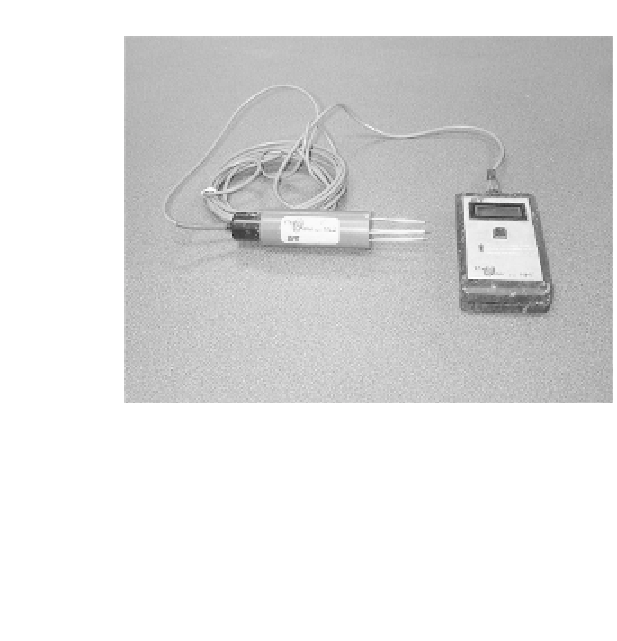Geoscience Reference
In-Depth Information
measure a positive pressure when the soil water is
held under pressure (e.g. during a rising water
table). The units of soil suction are Pascals, the SI
units for pressure.
Piezometers and wells
Most of the techniques described in this section have
been for the measurement of water in the un-
saturated zone. The main measurement techniques
for water in the saturated zone are through
piezo-
meters
and
wells
. Both of these measure the height
of the water table but in slightly different ways.
A
piezometer
is a tube with holes at the base that is
placed at depth within a soil or rock mantle. The
height of water recorded in the piezometer is thus
a record of the pressure exerted by the water at the
base of the tubing. A
well
has permeable sides all
the way up the tubing so that water can enter or exit
from anywhere up the column. Wells are commonly
used for water extraction and monitoring the water
table in unconfined aquifers. Piezometers are used
to measure the water pressure at different depths in
the aquifer.
Figure 4.11
The Theta probe (manufactured by
Delta-T devices). An example of a small, time domain
reflectometry instrument used to measure soil moisture
content in the field. The metal spikes are pushed into
the soil and the moisture level surrounding them is
measured.
way that these wave properties alter will vary,
dependent on the water content of the soil. TDR
measures the properties of microwaves as they are
passed through a soil and relates this to the soil
moisture content. Although this sounds relatively
simple it is a complicated technique that requires
detailed electronic technology. Up until the late
1990s this had restricted the usage of TDR to lab-
oratory experiments but there are now soil moisture
probes available that are small, robust and reliable
in a field situation. An example of this is the Theta
probe shown in Figure 4.11.
Measurement of infiltration rate
Infiltration rate is measured by recording the rate at
which water enters the soil. There are numerous
methods available to do this, the simplest being
a ring
infiltrometer
(see Figure 4.12). A solid ring
is pushed into the ground and a pond of water sits
on the soil (within the ring). This pond of water is
kept at a steady level by a reservoir held above the
ring. Recordings of the level of water in the reservoir
(with time) give a record of the infiltration rate. To
turn the infiltration volume into an infiltration
depth the volume of water needs to be divided by
the cross-sectional area of the ring.
A simple ring infiltrometer provides a measure
of the ponded infiltration rate, but there are several
associated problems. The first is that by using a
single ring a large amount of water may escape
around the sides of the ring, giving higher readings
than would be obtained from a completely saturated
Tensiometers
A
tensiometer
is used to measure the soil suction
pressure or soil moisture tension. This is the force
exerted by capillary forces and it increases as the
soil dries out. A tensiometer is a small ceramic cup
on the end of a sealed tube of water. The dry soil
attempts to suck the water from the water-filled
tube through the ceramic cup. At the top of the
tube a diaphragm measures the pressure exerted by
this suction. Tensiometers also have the ability to

